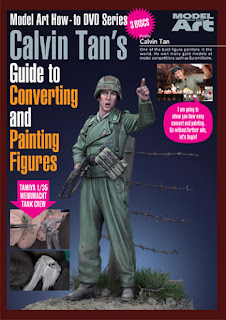FeR Miniatures - Hauptmann, Operation Barbarossa, 1941
After another long hiatus, I have finally found some precious time to wet my brushes on this 1/16 scale bust from FeR Miniatures sculpted by Pedro Fernández. The fact is that this bust is Michael's souvenir item from attending Fernando and Jaume's painting workshop in Korea last November. Only a small part of the face was painted by Michael but he lost interest in it and I offered to bring it to completion.
In retrospect this turned out to be a very quick, casual and fun painting exercise spanning over three days. Having recently been reacquainted to the painting manner of the Neo-impressionist - in particular Maximilien Luce, close scrutiny of this recent endeavor will reveal a variety of different hues like green and orange for the face and magenta for the tunic.
For some out there, you might think that this boarders on the crazy than unconventional. Therefore to dial things back a little, consider the conventional approach of using black to darken the base color to produce a shade for the shadow and white to lighten the base color to produce a tint for the highlight. The offspring between black and white is non other than gray. Excellent for subdued results as it produces in a cold and dull appearance - but extremely unappealing when over used. (I would like to call them "Grey Marriages"- often dwell either faraway or in the shadows). Most Impressionist artists use pure hues instead of adding black for shades for shadows to circumvent this. This is known as the analogous color scheme. An example is the use of Hookers Green (a hue color) to shade Sap Green (hue color). This results in a very rich and warm appearance - a characteristic style of the Impressionists. No doubt the visual results are rich and vibrant, it also appears artificial and synthetic. As a counter measure, the impressionists also incorporated the use of complementary color schemes in their works.
Observe that I have also opted to retain some brush strokes instead of smoothing them over as in this scale the different colors and gradient transitions can be optically "blended" when viewed in the flesh - as it related to the Divisionist principles employed by the Neo-impressionists.
Notwithstanding the absence of a step-by-step photo-documented journal, I do hope that a conceptual overview of my current approach will be just as beneficial and enlightening.
On a lighter note, here are some pictures from my recent holiday trip with the Mrs to Korea last week.
If you are curious how it was like during my first trip to Korea back in 2008, click HERE for a then and now comparison.
Cheers,
Calvin



























5 comments:
Great to see you back and painting Calvin!
Great job in this little bust
cheers
jaume
Thanks for the warm welcome back. Feels great to pick up the brushes again.
Cheers,
Calvin
Finally!
Great to hear from you again after almost two years.
Great painting (as usually).
I bought your book when it was published (I think in 2005) and with this people started to learn, use and work with acrylics.
You gave them a new stage of possibilities.
I think that you have given the start to a new period at that time.
Thanks for this!
Joachim
Very happy to see you back painting!
we miss you!
Really really happy to see you back and post something.
Please keep posting and inspiring us !
A warm welcome back from the Luxembourg.
Post a Comment